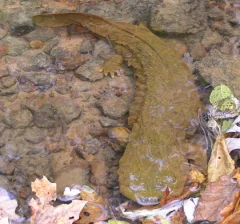- On April 17, the U.S. Fish and Wildlife Service (USFWS) proposed rescinding the definition of “harm” in the Endangered Species Act (ESA). Consequently, conservationists are concerned the state’s endangered species—from the Eastern hellbender to the Indiana bat—could be less protected than they were before.
-
“It completely changes the paradigm,” said Dan Boritt, executive director of the Indiana Wildlife Federation, a group that promotes wildlife conservation in the state. The USFWS’s proposal could make the Endangered Species Act essentially “toothless.”
The rule change revolves around the ESA’ definition of “harm,” Boritt said. Currently, harming a species includes destroying the resources they rely on for survival, including their habitat and food sources. Conservationists like Boritt are interpreting the proposal to mean that “harm” only applies if a species is directly harmed. Hunting an endangered species would be illegal, but destroying the species’ habitat would not be under this rule change, even though habitat loss would negatively impact the species.
Boritt said that acts like the ESA were created to protect listed species, but this is only possible if the factors they need to survive are also protected. Additionally, a population needs to be able to successfully reproduce in order to replenish their declining numbers.
Indiana could face consequences more dire than other states, Boritt said. If the power of the ESA is weakened, individual states can step up by enacting stricter laws. But in light of executive orders from Gov. Mike Braun saying that state environmental regulations cannot supersede federal regulations, this may not be the case in Indiana, Boritt said.
Mike Leahy, senior director of wildlife, hunting and fishing policy for the National Wildlife Federation, said the ESA has been valuable in providing solid guidelines for industry to follow. Rescinding the definition of “harm” reduces clarity as to what is and is not legal. Consequently, factors may have to be argued on a case-by-case basis, something that is both time consuming and expensive—especially for nonprofit conservation organizations.
“Most conservation entities aren’t flushed with cash that they’re able to go litigate in court every single nuance of every division,” Boritt said.
A number of vital species make their home in Indiana, and people like Boritt and Leahy are concerned this proposal will affect many of them.
Eastern hellbender
The Eastern hellbender is an aquatic salamander—the largest in the country, capable of growing to two feet long. Found along the southeastern border of Indiana, this species relies on cool, fast-moving streams with rocky bottoms and is vital in managingcrayfish populations, their primary food source.
At the same time, young hellbenders are an important part of the diet of fish and can serve as indicators of larger environmental issues. They are incredibly sensitive to pollution and erosion—contamination from agricultural practices have long been affecting the species’ survival. The diverse ecosystems they inhabit serve as a marker for where other rare species exist.
As the current definition stands, the water, rocks and food sources that the Eastern hellbender relies on are all protected by the ESA. Under the interpretation of conservationists like Boritt, a chemical plant could legally discharge a chemical into the river that the hellbender inhabits or put a dam upstream that stops the flow of water. Although these actions would contaminate or eliminate the hellbender’s habitat, because the harm would be indirect, the situation would be legal.
Freshwater mussels
Freshwater mussels are another example. Over 80% of freshwater mussel species in the world are endangered, and over 20% have gone extinct. In Indiana, the state has lost around half of its 80 native freshwater mussel species. Their shells have been valued to create buttons, beads and other jewelry, leading to extinctions. Although this demand has died down, freshwater mussels now face another threat: loss of habitat.
Relatively immobile, there is little they can do when their home is threatened. If the ESA rule change legalizes installing a dam upstream and halting water flow, the mussels living there are likely to die, Boritt said. Right now, without this rule change, this cannot be done without substantial review on the impact it would have on the population.
Freshwater mussels have significance in filtering bacteria and harmful sediment in the water they reside in, fostering healthy ecosystems for other animals while also being a food source. They indicate good water quality, and the shells they leave behind after dying can be used by other organisms as a habitat. Their loss could greatly affect the species and habitat that relies on them.
Indiana bat
The Indiana bat is an endangered species in the midst of a battle with white-nose syndrome—a disease caused by a fungus theorized to have been introduced to the species by cave explorers.
For this reason, caves across the state are closed off, especially during the bats’ hibernation season, Leahy said, to prevent the introduction of white-nose syndrome. Leahy said he is concerned the USFWS’ rule change would allow visitors to enter the cave, potentially bringing in the deadly fungus and negatively impacting the bat species.
Bat species in general can eat up to 1,000 insects a night, making them helpful in managing mosquito populations.
Extinction is forever
Rescinding the definition of “harm” is following the trend of reducing the power of the Environmental Protection Agency as administrators also reconsider regulations on power plants and the oil industry, air quality standards and emissions standards.
“There is not definitive clarity on what exactly will happen, how it will play out. A lot of it will be up to interpretation,” Boritt said. “But my greatest fear is, given how we have kind of seen a lessening by the courts of our agency’s ability to interpret rules, I think the guess is it would not be beneficial to the agency and the regulatory abilities of said agencies.”
The decrease in regulations may be intended to reduce barriers for development, industry and energy production, Boritt said. Regulations may be seen as overly burdensome—which may be true in some instances, Boritt said, but reducing regulations should be done thoughtfully and with consideration of the consequences.
The 30-day comment period for the ESA rule change is closed, and Boritt assumes the vast majority were against the rule change.
“I think this proposal to eliminate the definition of harm under the Endangered Species Act struck a nerve in a way that I haven’t seen in a long time with wildlife,” Leahy said.
The connection between wildlife and their habitat has been established for decades, making this proposal shocking for many and stirring up concern for those who value the existence of the Eastern hellbender, freshwater mussels, the Indiana Bat and the state’s other endangered species.
But now public attention has died down in light of other conservation risks, Boritt said.
“The easiest phrase is, ‘Extinction is forever,’” he said. “This will potentially unleash actions that are irreversible, and the harm could be catastrophic for definitely populations if not entire species. Once you take the gloves off, you don’t put them back on in this case.”
Olivia O’Neal is a reporter for TheStatehouseFile.com, a news site powered by Franklin College journalism students.





